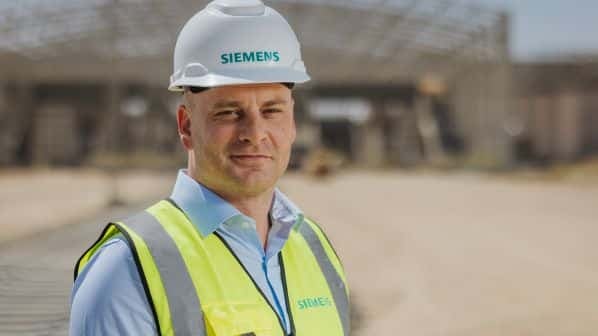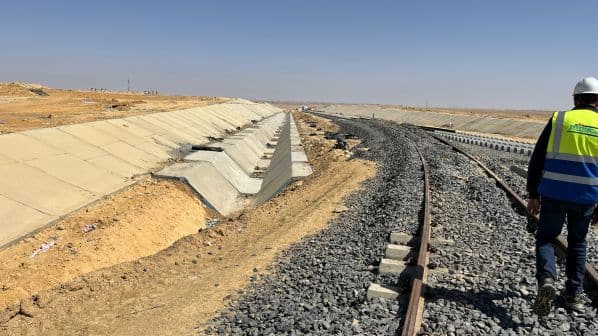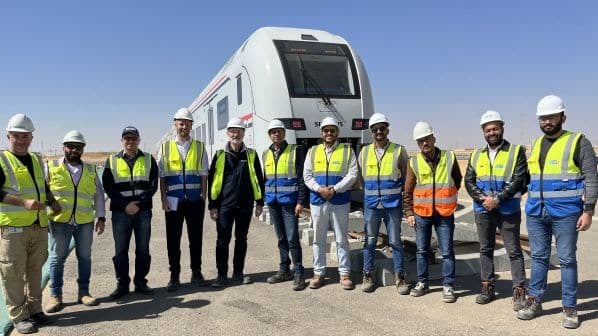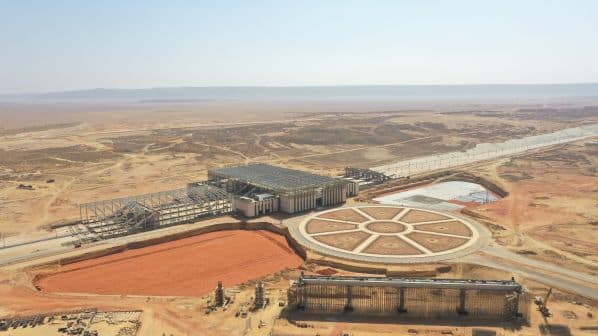IT’s a Wednesday morning and the project office for the Siemens Mobility, Orascom, and Arab Contractors (SOAC) consortium delivering Egypt’s new high-speed railway is busy. Weekly meetings are underway in adjoining temporary buildings between various SOAC teams working on the project, which is showing encouraging signs of progress.
This is apparent to anyone arriving at the National Administrative Capital (NAC) station office by road. A four-car Desiro HC EMU stationed on a temporary track above the office site comes sweeping into view. The train was delivered in November and is one of three types of rolling stock that Siemens Mobility is supplying to operate on the new 1985km, 250km/h mixed passenger and freight network. The first Velaro high-speed train is expected in Egypt by the end of the year, while Vectron electric locomotives are under construction in Munich.
Adjacent to the train is a helipad, ready to receive the next high-level dignitary keen to keep tabs on one of Egypt’s flagship mega projects. As well as inspecting the train, a visit will likely include tours of a nearby light maintenance depot that will eventually accommodate up to 10 Desiro EMUs and where fit out is underway, and the construction site for the future NAC high-speed station. Here the main building, four platforms that will serve six tracks, and bridge structures are all taking shape.
Right now, the station is geographically isolated. All around is sparse desert with jagged rocks hinting at some of the wider project’s biggest challenges. Yet the area is awash with new construction, which promises to transform it into a hive of activity in the coming years.
Around 100m from the main station building are the few first piers of a future extension of elevated Capital Train suburban line, dubbed LRT, that will provide a direct 20.4km connection to the centre of the NAC, the fringes of which are visible in the distance to the north. It is possible to make out some of the new but as yet unoccupied residential buildings that will house some of the future 6.5 million residents of Egypt’s new capital. They are flanked by the new eight-lane Ain Sokhna Road, which connects Cairo with the Red Sea coast, while a recently completed 4.8GW natural gas power station, one of the largest of its kind in the world, is also prominent on the horizon.
The new network is the largest single high-speed construction project underway anywhere in the world.
The station itself is expected to become a destination in its own right. A new hospital, school and shopping mall are planned for the 120ha site, which is being built by domestic contractor SIAC Construction. With a vast car park, it is also likely to serve as a drop-off point for visitors to the adjacent International Olympic City, which will be served by the LRT line. A brand-new 93,000-seater stadium is the centrepiece of the complex, which also houses other arenas, and is nearing completion as Egypt gears up to bid for the 2036 Olympic and Paralympic Games. On the other side of the highway from the stadium is the 470ha Octagon, the future home of the Egyptian Ministry of Defence, which will be the largest such facility in the world, surpassing the Pentagon, when it opens.

The extent of the progress made on the high-speed railway becomes especially striking during a visit to a construction site east of the station. By March, 55% of groundworks for the 660km Green Line have been completed by local contractors working alongside the National Authority for Tunnels (NAT), a division of Egypt’s Ministry of Transport. The civil engineering work is impressive. Extensive culverts and adjacent ditches run alongside the entire formation which heads off into the distance towards the Red Sea. It might not rain very often in the Egyptian desert, but when it does, flooding is common, and these risks must be averted.
Progress with the initial stages of tracklaying is similarly apparent at a busy welding plant, the network’s first, where stacks of 18m-long rails supplied by British Steel and JSW, Italy, are welded into 306m-long sections of 17 rails, all of which are individually tagged. Around 3km of track has already been laid on the initial 90km stretch of the line that will run from Ain Sokhna via the new NAC station to Mohamed Naguib and the depot at October Gardens. A tracklaying machine supplied by Plasser & Theurer, one of seven machines it is providing for the project, is stabled adjacent to the welding plant during IRJ’s visit. It is poised to continue the next stage of construction, completing up to 15km of double track per month.
Installation is also virtually complete of the first transformer and substation that will provide power to the initial 90km section of the 25kV ac electrified railway, Egypt’s first electrified main line. Thousands of catenary masts have already been delivered and piling work has begun. This installation work is being conducted using specialist machines supplied by Italy’s Tesmec.
TSO, a subsidiary of NGE, France, is responsible for tracklaying, including more than 100 turnouts, on the 330km Ain Sokhna - Cairo - October 6 City - Borg El Arab section of the Green Line. Orascom and Arab Contractors also awarded Salcef, Italy, a €300m contract to undertake tracklaying on the remaining 330km northern section, which connects Borg El Araba with El-Alamein and Alexandria on the Mediterranean Sea, and includes the 200km Phase 2 West from El-Alamein to Marsa Matrouh. The line will have a total of 21 stations.
The second route, the Blue Line, will run for around 1100km from Greater Cairo, south via Luxor to Abu Simbel, close to the Sudan border. NAT reports that 15% of this line is already complete. A third route, the 225km Red Line, is planned to connect archaeological sites in Luxor, running from Qena to Hurghada and Safaga, both ports on the Red Sea, which will improve connectivity for freight services. There will be around 70 stations in total across the network, with the precise number and location of some yet to be decided. Studies are underway for a fourth phase that would extend the network east for 250km and 14 stations along the coast from Abu Qir in Alexandria to Port Said and the Suez Canal.
Intriguingly, the new network is the largest single high-speed construction project underway anywhere in the world and completion will propel Egypt into sixth position on the list of the world’s largest national high-speed networks, comparable with Japan and Germany. The network will be accessible to 90% of the Egyptian population in 60 cities when completed. Passenger numbers are estimated at 500 million per year, which promises to change the dynamics of travel within the country.
For example, a journey by train from Cairo to Aswan takes around 13 hours today, but will take only 6 hours by high-speed rail. The network will make it possible for tourists and locals to make day trips from Cairo and other cities to Luxor as well as other historical and archaeological sites in the south. Commuter services will similarly improve access to employment and education, while new freight services that will predominately operate at night will provide an alternative to moving goods through the Suez Canal as well as improving domestic freight transport.
Ambition
Egypt’s plans for a high-speed railway date back to 2015 when Ineco was contracted to conduct a feasibility study for an initial 600km line from Cairo to Luxor. Tendering for the project took place. However, while a Chinese-led consortium was reported as making a proposal to build and equip the line in 2020, the project was apparently aborted.
As Mr Léon Soulier, CEO of turnkey at Siemens Mobility, reveals to IRJ, at this point Siemens, together with Orascom and Arab Contractors, made an alternative proposal directly to the Egyptian government. Rather than a “super turnkey” model where all civils work are executed by international contractors, they proposed splitting the project into two: Package 1, comprising the formation, would be the responsibility of NAT, which would employ local civils contractors and pay for work from its budget; and Package 2, the superstructure - anything from the track bed up - would be delivered by SOAC, and mainly financed commercial banks with export credit agency coverage (see panel below).
An initial memorandum of understanding (MoU) was signed by SOAC and NAT in January 2021, followed by a €2.7bn preliminary contract in September 2021 for the initial 660km route and the full contract for the 1985km network in May 2022.
The agreement is worth €8.1bn to Siemens and is described as the largest single contract in the 175-year history of the company. The turnkey agreement includes the design, construction, and 15 years maintenance of the network. Siemens Mobility is supplying 41 eight-car Velaro high-speed trains, 94 four-car Desiro EMUs and 41 Vectron freight locomotives. Siemens will also install ETCS Level 2, the traction power supply system, and its digital Railigent system for asset and maintenance management.
International finance to the fore
THE National Authority for Tunnels (NAT) is contributing 15% of the total cost of the Green Line project with the remaining 85% coming from commercial banks through from Export Credit Agency (ECA) finance.
Specifically, Euler Hermes, a subsidiary of Allianz, is guaranteeing €1.99bn of financing for the 660km first phase of the Green Line for the system and rolling stock component of the agreement. The lead arrangers are Deutsche Bank, Credit Agricole Corporate and Investment Bank, Banco Santander and Bayerische Landesbank.
In addition, the Islamic Development Bank approved $US 344.5m for NAT to finance the civil works part of the project in April 2023.
NAT is working with several international financial institutions to secure substantial ECA-backed loans for the second phase of the project.
The consortium will maintain the fleet and the infrastructure for 15 years. Rolling stock will be maintained at three facilities on the Green Line at the NAC site, Borg El Arab and Marsa Matrouh, as well as at the main depot on the Giza plateau at October Gardens, close to Hadayek October station, construction of which Siemens says is a priority. The depot will have capacity for 26 Desiros, 11 Velaros and 12 Vectron locomotives.
Soulier explains that Siemens has a long history with its consortium partners Orascom and Arab Contractors, who he says have decades of experience with railways. They also partnered with Siemens to deliver recent power and healthcare projects in Egypt, while Siemens has worked in the Egyptian transport market for over 40 years.
German interest in the project extends to operations. A joint venture of German Rail (DB) subsidiary DB International Operations (DB IO) and Egyptian firm Elsewedy Electric were awarded an initial 15-year, “single digit billion euro” contract to operate the future service and manage infrastructure and rolling stock for high-speed, regional and freight operations by the Egyptian government in 2022.
European standards
Egypt’s experience with railways dates to the network built by the British in the 19th century. Soulier says this project will propel the country into the 21st century. This is apparent in the adoption of European standards for construction. “There are no shortcuts,” Soulier says, adding that the contract it has is “very thin” when it comes to technical specifications.
“Our Egyptian customer basically said ‘we want exactly what you have in Europe and you’re the company with the knowledge to deploy that and you need to show us how to roll that out’,” Soulier says. “We have independent safety assessors and I think that’s why they brought Siemens in because they wanted to have German technology and European standards. I also think this expedited approach is how Egypt can deliver a project such as this.”
Building a railway to such high standards presented a challenge in the rocky desert environment. Preliminary construction involved a variety of techniques to clear the path for the new line, from using pneumatic drills to blasting. Inevitably, there were challenges with this work, notably a 60m-deep cutting, close to Ain Sokhna station, where the alignment rises from the coastal plain in parallel with the Ain Sokhna Road.
NAT says the final alignment was determined after lengthy studies were completed in partnership with Systra on the topography and geology of the area through which the line runs. This has helped to ensure project safety and enabled construction to proceed relatively smoothly.

Other challenges are posed by the remoteness of the worksites - project staff say the only way to reach some areas is to drive on the service road built alongside the alignment. The intense desert heat - temperatures can exceed 50°C in the summer - means work schedules are often changed.
There are also the cultural challenges of an established European supplier working in a developing market. Mr Peter Papert, the consortium project director for the high-speed project at Siemens Mobility, says that project teams are consistently reinforcing the need for achieving the level of precision in construction that a 250km/h railway demands. He says exposing local partners working on the project to these expectations and requirements is helping them to become more informed and ultimately more skilled.
A similar approach is taken with worksite safety. Practices more commonly associated with European projects and worksites are in place and closely adhered to by anyone coming into contact with the project - during IRJ’s visit several third-party workers at one site were swiftly reprimanded for not wearing appropriate personal protective equipment (PPE). “Personal and system safety is very important to us, and we have brought all our experience to this project,” Papert says.
Several changes to the alignment have been made, specifically in the Valley of the Kings on the Red Line, where two additional crossings will be built over the Nile to avoid potentially sensitive areas. The Green Line will also be elevated in 6th of October City to prevent the railway from becoming a physical barrier between communities. In total 32.5km of the line will be elevated, including a 9.2km bridge that has a 2.5km section over the Nile, one of the most eye-catching structures on the Green Line.
Egypt has experienced supply chain challenges in the last few years. As Soulier explains, such difficulties are expected with any project of this size and scope. And while inflation issues are more pronounced in Egypt at present, he is heartened by the international community’s financial and political support for the project, as well as the Egyptian government’s sheer will to get it done. “We see no relinquishing of focus, or strength, or attention on this project whatsoever,” he says.
What’s next?
Upcoming milestones include delivery of more trains, which will ultimately peak at five per month, and completing access to the October Gardens depot. Soulier says the start of dynamic testing on the initial 90km section will begin with the first train by the end of this year or in early 2025, depending on the completion of the Nile bridge. Tracklaying teams will also continue to expand their work as more sections of the alignment are handed over to SOAC under its “sequential” approach to delivering the project. Work on the Red Line is likewise set to step up relatively soon.
“There is more progress here on a monthly basis than you would see in years elsewhere.”
Léon Soulier
“From the moment we get access to a certain site, our obligation is to finalise the work within two or three years,” Soulier says. “As long as the sites keep coming in, completion will continue in stages until we reach final completion.”
The operation of the first electric mainline trains running in Egypt will be a key milestone for the project. No firm deadline for a grand opening has been set, or at least made public. However, Soulier hints that the opening of the first section from Cairo to Ain Soukna should happen “not too long from now.”
In an era where other high-speed projects have run into cost and delivery challenges, Egypt appears to be bucking the trend. The environment is different certainly, but the sheer will to complete what is a flagship infrastructure project for the government, and a transformational project for wider society, is driving what Soulier describes as an “astonishing” level of progress.
“In any other part of the world, this is a project that would take decades,” he says. “There is more progress here on a monthly basis than you would see in years elsewhere.”
A Desiro built for the desert
THE first 160km/h Desiro EMU was delivered to Egypt in October and proudly displayed at the TransMEA trade fair held in Cairo in November.

NAT station site.
The train was subsequently transferred to the NAC station site where commissioning is taking place. During this phase, power is provided from an external source every Wednesday to make sure that all onboard systems are working correctly, including the powerful air-conditioning. Once a month, on a Thursday, the train is moved by a battery-powered shunting locomotive back and forth four times on a short 50m-long section of track.
The four-car Desiro EMU consists of two single-deck end cars and two double-deck intermediate vehicles. It is based on the high-capacity Desiro delivered for the Rhine-Ruhr Express network in Germany, but with major modifications made for “sandification,” drawing on Siemens’ experience of supplying similar trains to other countries in the region.
The importance of keeping sand out is reflected in the plugging of all holes, and the use of specialist filters for the air-conditioning system. Bespoke spoilers are deployed between the cars to reduce exposure to the sun in desert sections and simultaneously minimise potential sand ingress. Sand-resistant paint has also been used for the livery, which incorporates the Egyptian flag.

